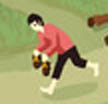By Greg Downey; (long read: 5500 words)
Moulay Ismail ibn Sharif succeeded to the sultanate of Morocco after his brother fell from a horse and died in 1672. Twenty-six when he became the Sharifian Emperor, Moulay Ismael “the Bloodthirsty” — as he was called — went on to expand his holding in a remarkable reign. His armies conquered neighboring territories and fought off the Ottomans (eventually forcing them to recognize Moroccan independence), and the emperor went on a building spree to make Meknes a rival to Versailles, with French engineers to help.

Moulay Ismail Ibn Sharif, anonymous engraver 1719 (public domain)
Moulay Ismael also had a prodigious capacity for cruelty. He legendarily ordered that the walls of Meknes be decorated with the heads of 10,000 enemy soldiers. He also sponsored the Barbary pirates, who engaged the states of Europe in a protracted and costly low-grade war, drove the American colonies to form the first navy in North America, and pushed the English and Spanish from Moroccan territory.
But Moulay Ismael is probably best known to history because of his prodigious capacity to reproduce. The emperor had a thing for children,… well, for having sons, that is.
According to the Guinness Book of World Records, Moulay Ismael, with four wives and at least 500 concubines, sired an estimated 1042 children (they recently raised their estimate from 888). That feat is even more incredible when one notes that Moulay Ismael, demonstrating just how deep his cruelty went, ordered that all the female infants of his concubines be smothered when they were born by their midwives.
A recent paper by Elisabeth Oberzaucher and Karl Grammer (2014) in PLOS One set out to test whether the number of children attributed to Moulay Ismael was even plausible. They used a number of computer simulations, taking into account a range of estimates of human fertility, to see if one man could in fact sire so many children.
More specifically, the two researchers from the Department of Anthropology at the University of Vienna tested the claims of French diplomat Dominique Busnot, who on a visit to Morocco in 1704, when Moulay Ismael was 57 years-old, reported that the emperor had six hundred sons. Was it plausible for the emperor to have had six hundred sons — as well as all the daughters who would have been killed at birth — during a period of thirty-two years (from taking the throne at age 25 until Busnot’s arrival)?
The question is important, not merely to establish how much sex would have been necessary to achieve this extraordinary level of reproduction — once a day? twice a day? — but also because it suggests a theoretical limit to male fertility.
The case of Moulay Ismael’s harem, as Oberzaucher and Grammer note, is widely cited in ‘textbooks on evolutionary psychology and biology’ (2014: 1; for an online version, see Jerry Coyne’s blog, Why Evolution Is True). The alleged number of Moulay Ismael’s progeny is important for our understanding of human reproduction and sexuality, especially from an evolutionary perspective.
How plausible is Emperor Moulay Ismael?
Oberzaucher and Grammer decided to test only the number claimed by Busnot in his first visit to Morocco in 1704 because Busnot’s account is the most complete, and there’s clear data for the relevant reproductive lifespan. As the researchers point out, however, because of Moulay Ismael’s infanticide of daughters — only the daughters of his four wives were allowed to live — we have to assume that his fertility was much higher than the total number of children reported by Busnot. They suggest that the estimate to test is ‘approximately 1171 children from 500 women in a reproductive time span of 32 years (25–57)’ given the expected male-female ratio of offspring (ibid.). Could one man have done this?
Of course, experimental methods of testing the limit of male fertility are sort of out of the question, so the historical cases of extreme reproduction like Moulay Ismail and Genghis Khan are extraordinarily important. But because these historical accounts are subject to all sorts of biases, the computer simulation route seems to be one of the few ways to test the claims made in these records.
Einon (1995), for example, claims that Busnot’s account is not plausible, based on a set of assumptions about sperm survival, female infertility rates, likelihood of conception, and chances of spontaneous miscarriage. Gould (2000) countered that Moulay Ismael in fact could have produced the hundreds of children attributed to him by contemporary accounts; according to Gould, Einon underestimated potential fertility due to a number of incorrect assumptions, including the fertility of young women, the length of time sperm could survive after ejaculation, and even the number of years available to Moulay Ismael for reproduction.
Virtual Moulay Ismael — extreme fertility simulators
To test the claims about Moulay Ismael, Oberzaucher and Grammer had to extrapolate from fertility models based on very different conditions. That is, most of what we know about fertility was not learned in the context of what we might call ‘extreme polygyny’. The researchers used three different models of fertility, all based on longitudinal data from couples in long-term relationships trying to conceive.
Using a range of conservative assumptions in these models, Oberzaucher and Grammer ran the three different simulations to test, first, how many times would a man have to copulate each day to reach the target (1171 offspring in 32 years) and, second, what number of offspring would be reached in 32 years under a range of conditions. As they write:
We reran the simulations four times, once with ovulation detection and without sperm ageing, once without ovulation detection and sperm ageing, once with both, ovulation detection and sperm ageing, and once with sperm ageing and without ovulation detection.
Sperm ageing was a crucial variable because it gradually decreases the chance of fertility. In those simulations with ‘sperm ageing,’ Oberzaucher and Grammer adjusted the chance of conception downward by 1.52% per year. Because they ran simulations both with and without a variable for sperm ageing, the research shows how this factor might influence overall male fertility.

The Mausoleum of Moulay Ismael in Meknès
Photo by: Josep Renalias (CC BY SA)
‘Ovulation detection’ likewise is key because it would theoretically make conception more likely, driving up fertility (assuming that Moulay Ismael actively sought to produce children). Although ovulation detection is possible through testing a woman’s vaginal mucous, Oberzaucher and Grammer didn’t know if any form of this technique occurred during Moulay Ismael’s reign.
Even without knowledge of the symptoms of ovulation, ovulation detection effects may also result unconsciously if ovulating women are more attractive to their partners, or seek intercourse more actively, as some research in evolutionary psychology suggests. Even religious or cultural constraints on intercourse with women during their menstrual periods might affect overall fertility as any menstrual taboo would lead to Moulay Ismael copulating more often with women in his harem during their window of greatest fertility. So modeling some effect for ovulation detection can make sense in a number of conditions.
Using a range of variables, Oberzaucher and Grammer find that it would have been possible for Moulay Ismael to have 1171 children; two of the models require, however, that he had sex around three times every two days, and that taboos on menstrual periods were in place, to really be plausible. Intercourse might have been less frequent if his wives and concubines experienced heightened fertility due to the emotional arousal of infrequent intercourse, as research on the wives of German soldiers during World War II suggested (they only had intercourse infrequently when their husbands had leave from the front) (see Oberzaucher and Grammer 2014: 2-3).
Depending upon the model and assumptions, ovulation detection can be particularly important, especially if decreasing male fertility is taken into account. If the potency of sperm decreases, choosing the women with which to use the shrinking resource (pun intended) grows in importance. Moreover, if sperm ageing is taken into account, heightened fertility rates — like those in the wives of German soldiers — become increasingly important to the simulation achieving the fertility goals.
Betzig (1992) reports that the Chinese emperor Fei-ti, one of the other men with the largest recorded harems, confined sexual contact with his wives and concubines to the fifth day after menstruation, suggesting that his contemporaries had some basic understanding of female fertility (as well as damn good bookkeeping for menstrual cycles; see Einon 1998: 415).
Dorothy Einon (1998) discusses how Moulay Ismael’s senior-most wife allegedly controlled who he slept with, although we don’t know if she had a pattern of selection that would have made the emperor more likely to encounter fertile partners. Einon (ibid.: 422) estimates that, if Moulay Ismael mated randomly with a chaste woman from his harem — avoiding her period of menstruation — he stood a 15.2% chance of meeting a woman at optimal fertility. (Oberzaucher and Grammer 2014 argue that she underestimates fertility, but that’s not terribly important for my purposes; check out their article if you want more.)
The bottom line though is that Oberzaucher and Grammer find that, even with fairly conservative estimates: ‘results indicate that the Emperor could have reached his notorious reproductive success with fewer copulations than assumed so far – thus the historic reports could be facts and not fancy’ (ibid.: 4). He would have had to be pretty damn determined, and remarkably persistent for three decades, but the number of children attributed to him by Busnot is at least plausible.
Possible complications
Paternity is one possible issue that could complicate the number of Moulay Ismael’s children. Moulay Ismael took extreme steps to ensure his paternity of all of his sons: he personally strangled any wife or concubine suspected of adultery, or he had their breasts cut off or their teeth pulled out. Men who looked at one of his concubines or wives were liable to be executed, even after the women were retired from his harem at age 30.
Although there might still have been some children in this group of 1171 with paternity other than the emperor, it’s probably safe to say that Moulay Ismael’s measures were among the most severe controls ever exercised over a large group of women’s fertility.
Another complication is, as Oberzaucher and Grammer put it, ‘love and favouritism’ (2014: 4). Most of their models treated the choice of partner as random. If Moulay Ismael began to favour one partner or another, his attempts to conceive could become non-random, or he could repeatedly have sex with one or a small number of his partners, and the total number of successful attempts would decrease. In other words, attachment costs fertility if you’re a bloodthirsty (and child-hungry) emperor. ‘Love’ or loyalty (or anything like them) can be a liability for overall fertility. Judging from what we know about Moulay Ismael, I suspect he wasn’t hampered too much by an over-abundance of attachment.
Another possible complication that Oberzaucher and Grammer mention, but don’t discuss in any length, is whether sperm potency is affected by frequent intercourse (2014: 2). Although they suggest that it’s not likely, I’m not convinced that we know, really, how frequent intercourse with a large number of different women would affect a man’s sperm count, potency, or other dimensions of ejaculation. There simply is no comparable case where research has been done, to my knowledge. Is there any ‘training effect’ on the testes? Do metabolic mechanisms that lead to higher sperm count during intercourse in humans when the partners have been separated (and thus there’s a chance of cuckoldry) become more pronounced in these extreme conditions? I wouldn’t rule it out, even though I suspect that there’s a limit to testicular ‘trainability’. Certainly, early research by Freund (1963) suggests that men cannot increase their ‘daily sperm output’ even with a substantial increase in the frequency of intercourse.
But women’s bodies, too, complicate the estimate because lower frequency of copulation can lead them to have longer, more irregular menstrual cycles (see Einon 1998). We also don’t know for certain what sort of diet the women in his harem had, and whether they were really getting sufficient nutrition to maintain peak fertility.
Why Moulay Ismael matters: parental investment theory
Admittedly, the case of Moulay Ismael the Bloodthirsty is interesting in and of itself. But his example is also important — and he gets discussed in contemporary literature in evolutionary theory — because he highlights potential male-female differences in human reproduction, and the likelihood that diverging strategies might arise in the sexes. Moulay Ismael, for some evolutionary theorists, represents not an aberrant, infamous abuse of power but rather the logical outcome of a particularly male reproductive strategy based on our reproductive biology (see, for example, this piece by Satoshi Kanazawa on why he argues mothers are better parents — spoiler: because evolution said so!).
Robert L. Trivers (1972), arguably among the most influential evolutionary theorists after Darwin, helped to outline the implications in his theory of ‘parental investment.’ Trivers suggested that the enormous disparity in the cost of reproducing between men and women meant that women’s and men’s reproductive strategies necessarily had diverged. The number of potential children, the energy cost of each offspring, and the frequency of reproduction possible led to profoundly different ‘investment’ demands for successful reproduction from each parent.
Parental investment theory highlighted that women could reproduce only slowly, as each child became increasingly independent. From conception, through pregnancy, with added time out for lactation amenorrhea (the period of decreased fertility from regular breast-feeding), our female ancestors probably had a birth-spacing of between three and six years.
A man like Moulay Ismael, in contrast, could reproduce much more frequently, if he could gain access to many mates. A man need invest very little in an offspring to pass on his genes — if someone else could be counted upon to raise and support his children. In contrast, women must invest much more: not just the nine months of carrying the child to term as well as the metabolic demands of nursing the infant, assuming that she could not get someone else to take over child-rearing, but even at the microscopic level of the biological contribution of gametes in conception.
Parental investment in miniature: anisogamy
At this microscopic level, the principle of anisogamy highlights that parental investment is unequal from the moment of conception. Anisogamy is asymmetry in the biological contribution of men’s and women’s bodies in conception: the idea that eggs are costly, and sperm, cheap. Anisogamy is central to most accounts of sexual differences in reproductive strategies (as well it should be).
A variety of contrasts characterize anisogamy: the ovum is the largest cell in a human body, and a sperm the smallest. Women release only one or two eggs during every menstrual cycle, or around twenty-nine days (with great variation), whereas men can relatively quickly ‘reload’ to make another attempt at reproduction. In fact, every ejaculation of a healthy male will have around 250 to 300 million sperm, although sperm count varies significantly. Up until about a year ago, it was virtually dogma to assume that women simply could not produce any new eggs during their lifetime, their supply slowly dwindling as the ‘biological clock’ on reproduction ticked down to senescence (see Wood, et al. 2012).
Many analyses of differences between men’s and women’s approaches to reproduction point to anisogamy, the larger ‘investment’ per gamete for women, as the most important dimension of male-female difference for understanding sex differences in mating strategy. As psychologist Dorothy Einon wrote:
In the time taken for a woman to complete the menstrual cycle that releases one ovum, a man could ejaculate 10 to 100 times. During the complete female reproductive cycle of 3 to 6 years, this figure could extend to thousands more ejaculations. It is this discrepancy in the frequency of releasing fertile gametes that lies behind claims that “most males can raise their reproduction by mating with many females” (Betzig 1992) and a “really reproductively successful son may grow up to father hundreds (thousands?) of children by hundreds (thousands?) of women” (Betzig 1997).
(See also a TED talk about ‘wild sex’ that I really love, in which Carin Bondar suggests that the fact that ‘sperm are cheap’ leads to an overall ‘more sex is better’ approach to reproduction in men).
Some evolutionary theorists even suggest that male fertility is potentially limitless, which is why Moulay Ismael is so important. (See Shackelford and Goetz 2009, and Togashi and Cox 2011 for a much more thorough discussion of the biology and evolution of anisogamy and sexual conflict in human reproduction.)
Anthropologist Kate Clancy compares anisogamy-based stories of human human sexuality and evolution to the predictable permutations of stories told by her three-year-old daughter. As Clancy describes, although her daughter’s stories have permutations and little wrinkles, they always follow ‘the same, uncomplicated arc’ involving a small cast of characters — Kate’s daughter, Kate, Dora and Diego — a net, and ‘Rescue Scissors.’ Clancy explains that ‘the framework borrowed heavily from one of the few mythologies known to my little girl: Dora the Explorer.’ Likewise:
Evolutionary psychology is often a kind of story-telling, and instead of borrowing from a preschool cartoon they borrow from the concept of anisogamy. Anisogamy is sexual reproduction formed by unequal gametes, in our lineage a big egg made by females and little sperm made by males. This provides the foundation for differential reproductive investment, where females often put in the time and effort of gestation, lactation and care. From here, proponents of EP see essential differences between what men and women want in relationships, and the kinds of relationships that are optimal, and a model this broad makes it possible to shoehorn any behavior into its adaptive framework.
The case of Moulay Ismael is important in this context because he seems to sketch out the limits of male fertility in practical terms and thus at least one of the limits of anisogamy as a theoretical explanation. (If you want more on sexual dimorphism and physiognomy, Patrick Clarkin’s series of human sexuality is great; this link is to part 4, on promiscuity and physiology)
The limits of male fertility: why not more than 1171?
The brute numerical comparison of egg and sperm — the more than 100-million-fold difference in the number of gametes — as a measure of parental investment asymmetry is misleading on a few levels. In the wild, sperm only really work in packs. Mobs really.
Davies and Shackelford (2008), for example, point out that males in a variety of species may have to produce so much sperm in order to reproduce successfully that the overall metabolic investment in the fertilized embryo may be higher for them than females with egg production.
The WHO has recently placed the lower limit of ‘normal’ human sperm concentrations at 15×106 sperm/mi;liliter of semen, down from the old recommendation of 20×106 sperm/ml; with the average ejaculation from 2 to 6 ml (Cooper et al. 2010). (Note that this change in the definition of ‘sub-fertility’ in men is itself controversial.) That would mean the lowest limit of health ejaculation would be around 30 or 40 million sperm, with more likely levels being around 280-480 million sperm per ejaculation (see Ryan & Jethá 2010). The number is staggering compared to the one, or at best two, eggs that are released at ovulation, but so is the number that is effectively ‘subfertile’ in men.
Sperm concentration drops off if a man has sex frequently, although I’ve found good recent research on this surprisingly difficult to come by. Bulls’ sperm production is way better understood.
Oldereid and colleagues (1984) found, in subjects asked to ejaculate every eight hours, that sperm count plummeted: starting at an average close to 300 million per ejaculation, concentrations dropped off to around 100 million on the second sample and even lower on subsequent samples. Averages from the third ejaculation on were at 50 million or lower — bouncing around fairly close to that ‘infertility’ level.
When Valsa and colleagues (2012) tried to investigate the effect on sperm of more frequent ejaculation — every four hours — they simply couldn’t get subjects to complete the experiment. Five of the eleven subjects dropped out after the third sample (that is, after eight hours,). Only one man managed to submit five samples in sixteen hours. The rest had discontinued due to ‘physical exhaustion.’ By the third sample, sperm count was bottoming out and didn’t rebound.
Historical records of extreme harems corroborate this insight in unusual fashion; some Chinese emperors, who themselves had quite large harems, allegedly reported that the sexual servicing of their harems grew oppressive (cited in Einon 1998: 416). Although having sex once or more times each day may not sound terribly ‘onerous,’ to get to over 1000 children, we’re talking about the ultra-ultra-marathon of male reproduction: decades of averaging these rates of intercourse, even with aging and periodic illness.

Lehnert & Landrock postcard from the 1910s or 1920s, public domain.
In classic work on the topic, Freund (1963) found that increasing a man’s ejaculation rate from 3.5 to 8.6 times per week (I’m not sure why the decimal places) led to a decrease in the total amount of sperm that men produced, even though the total volume of semen increased. So sperm concentrations dropped faster than overall sperm count. In fact, Freund found that a rigorous period to ‘deplete’ reserves of sperm led the men to lower levels of sperm output, even after more than 150 days of recovery!
One of the biggest limits on male fertility, however, is the peculiar form of female fertility in humans. That is, because women conceal when they are fertile and mate when they are not (unlike many animals), human males end up having a lot of sex that can’t lead to offspring. Einon (1998) points out that, because women’s bodies conceal ovulation, in took scientists until the 1920s to figure out the female hormonal cycle and the peak of fertility.
In other words, the idea that male fertility is practically infinite due to the hundreds of millions of sperm in a normal ejaculation is not really accurate. It may make for good science fiction, but it makes for lousy evolutionary theory. Hundreds of millions of sperm in an ejaculation — the brute fact of anisogamy — does not help us to understand the real trade-offs that determine male fertility and mating strategies unless we take into account a variety of other factors. That’s where Moulay Ismael, both the historical figure and the virtual model, comes in.
The long tail of reproductive success
One of the more interesting little insights turned up by Oberzaucher and Grammer’s Moulay Ismail simulators is that most of his harem, from the point of view of maximizing reproduction, was superfluous. They found that:
With our simulation we could also provide evidence that the harem size is of lesser importance for the achievement of the reported reproductive success than thought so far. A breeding pool of 65 to 110 women leads to the maximum reproductive outcome. This highlights the importance of incorporating cost-benefit calculations – increasing the size of the breeding pool beyond that point increases the costs without additional benefits to outweigh them. (Oberzaucher and Grammer 2014: 4)
In other words, at least according to the simulation, Moulay Ismael demonstrates that the unlimited fertility of men is a myth. If anything, his harem squandered a significant part of his wives’ and concubines’ potential fertility. Of course, having a harem of more than 110 women still has reproductive consequences, as the researchers suggest:
Having a harem of 500 concubines might have been due to other considerations than maximization of individual reproductive outcome. For example, it could have been a means to remove the additional women from the reach of other men, thus depriving them of reproductive potential. (Oberzaucher and Grammer 2014: 4)
Although as a personal reproductive strategy, the Moulay Ismael ‘only-I-get-to-make-babies’ approach might be a winner, as a group’s reproductive strategy, it’s terrible.
If anything, Moulay Ismael’s extreme polygyny put a huge dent in the overall fertility of his capital city. The average fertility rate for the women in his harem was much lower than it would have been had they been in much-less-polygynous mating relationships. Even more dramatically, in order to maintain a rolling harem of 500 women under 30 — when they were forced to ‘retire’ — some estimates suggest that he would have had to have amassed over four thousand wives and concubines over his lifetime. Given that it was a capital offense to have sex even with a former member of his harem, this puts his alleged fertility in a whole new light. Against this number — four thousand women — 1171 children is actually a staggeringly low rate of fertility, a measure of how inefficient a single man is at making use of the fecundity of a large number of women.
When I wrote about this in my little ebook on human evolution (Becoming Human, free from Apple’s iBookstore or in a variety of formats from Smashwords), I contrast Moulay Ismael’s reproductive inefficiency with the case of the wife of Russian man, Feodor Vassilyev. We don’t even know her name because no one recorded it, but Mrs. Vassilyev gave birth to 67 children during her lifetime, including sixteen sets of twins, seven sets of triplets, and four sets of quadruplets.
Compared to the women in Moulay Ismael’s harem, whose lifetime fertility averaged less than a single child for each woman, Mrs. Vassilyev is a demographic force, with a reproduction rate over 200 times higher (with Moulay Ismael’s likely four thousand wives and concubines responsible for .3 child/woman). A population that reproduced like Moulay Ismael would quickly be overrun by a population that bred like the Vassilyevs (granted, both are impossible).
(Please note, I realize that Moulay Ismael is actually alleged to have produced more children subsequent to Busnot’s account, but I’m just trying to keep this fairly straightforward. Even if we allow for a lifetime fertility rate in the harem of .5 child/woman, the gap between Mrs. Vassilyev and these women is still well over 100 times greater lifetime fertility, assuming that wives and concubines of Moulay Ismael didn’t go on to reproduce more after they left him.)
What does Moulay Ismael really teach us?
To me, the extraordinary reproductive monopoly that Moulay Ismael demanded, and his impressive, albeit inefficient output of offspring, doesn’t really offer an unobstructed view of unfettered ‘human nature’ any more than the prodigious maternal accomplishments of Mrs. Vassilyev do. Both staggering feats of reproduction demonstrate that human fertility is not simply constrained by the supply of eggs or sperm. Other limits are just as crucial, including both metabolic and social factors. Most people get nowhere near their maximum theoretical fecundity.
The kind of reproduction Mrs. Vassilyev achieved was only possible given a sedentary, agricultural life style, with enormous support to provision for all her offspring, including probably from her own children. Likewise, Moulay Ismael’s reproductive success didn’t just depend upon his longevity and the remarkable durability of his testes, but also upon the social and political organization that went into his conquests and empire building, as well as a lot of naked coercive power.
You could say that it took him an army of 100,000 soldiers to have 1000 children (and probably a whole bunch of eunuchs to make sure that the 1000 were, in fact, his).
Both Mrs. Vassilyev and Moulay Ismael could only accomplish what they did because human reproduction broke many of the constraints that limited the birth rates and fecundity of other great apes, setting our human ancestors on a quite different course of reproduction.
To really understand human reproduction in evolutionary perspective, you can’t just compare men and women; you have to also compare humans to non-humans, especially other primates.
Human birth spacing
Human birth spacing is kind of strange relative to other great apes. We have the most immature, dependent young among modern apes; our lifestyle is so dependent on learning and complex skills that, in foraging groups for which we have clear data, individuals are not producing more calories than they are consuming until well into the second decade of their lives. The threshold of self-sufficiency takes us much longer to cross than other apes, so we might expect long periods of maternal dependence in our offspring and resulting slow reproduction rates.
And yet, our birth spacing is relatively short. Galdikas and Wood (1990) studied a foraging group in Papua New Guinea and estimated that the birth spacing, if the previous child lived, averaged around 43 months . The birth spacing in gorillas was pretty similar, but chimpanzees needed more like five-and-a-half years, and orangutans almost eight years. With our longer lives, this translates into more potential children. In addition, agriculture shortened human birth spacing still more, not only because of the more consistent food source, but also because of sedentary life.
In other words, part of what made our ancestors an invasive ape, a colonizing species with a potential for demographic explosion, was the way our ancestors reproduced. Without this change to our fecundity, this extreme potential for fertility that we see so dramatically illustrated in Moulay Ismael and Mrs. Vassilyev, the effects of agriculture and later gains in hygiene and decreased mortality would not have been so great.
In fact, if anything, Moulay Ismael and Mrs. Vassilyev show us that human accomplishments in areas like improved nutrition, social cooperation, niche construction (including removing predators and decreasing infant mortality), and even political sophistication can affect the most fundamental biological forces of our evolutionary heritage: the capacity of our bodies to pass on our DNA.
As Kate Clancy warns, starting from anisogamy as the foundational fact of human mating predictably produces a skewed account of human reproduction, and it virtually assures that we will focus on male-female differences. Starting from Moulay Ismael can produce a warped sense of how human reproduction works, as Dorothy Einon (1998) also cautions. Oberzaucher and Grammer’s simulations are especially interesting to me because they highlight limits of any account that ignores numerous constraints on fertility, including male fertility. The reproductive process is complicated at a variety of levels, including the way that male and female fertility interact and how human awareness of ovulation (or lack of it) influence fecundity.
The ‘Long, Slow Sexual Revolution’ redux
A couple of years ago, I began arguing that one way to talk publicly about human reproduction and male-female differences from an evolutionary perspective, a way that avoided over-simplification, was to discuss how human reproduction became different from our ancestors’ patterns and from the other great apes. My goal is not to minimize male-female differences (after all, one cannot imagine a female Moulay Ismael). Rather, it is to draw the discussion of reproduction into the whole account of the emergence of human distinctiveness rather than let it remain anthropocentric and anachronistic, focusing only on humans in the present.
Too often, popular evolutionary psychology (the kind in news magazines and press releases) focuses exclusively on modern male-female differences, rather than the emergence of human distinctiveness. Don’t get me wrong; I’m not arguing that humans alone are exceptional. All apes reproduce in their own ways, and noticing this, and thinking about the comparisons, are key to understanding that human distinctiveness.
My argument, in short, is that humans evolved to be different from other apes, in part, because our ancestors mated, reproduced, and raised our offspring in ways that weren’t just different to other apes, but liable to be affected by our increasing cognitive, social, technological, and perceptual abilities. Sex unifies us with other living things, sure, but the way that we do it is distinctly human, in ways that are crucial for making us what we are today. We are able to change the manner in which we reproduce, both intentionally and unintentionally, boosting our fertility.
I proposed that, as shorthand, to short circuit the ‘Men-Are-From-Mars-Women-Are-From-Venus’ default setting when talking about sex, we discuss instead the ‘Long, Slow Sexual Revolution.’ The ‘Long, Slow Sexual Revolution’ is a multiple-million-year-long process that eventually leads to explosive reproductive success, unlike other apes, because it produced fecundity, or untapped potential for high rates of reproduction. When the conditions were right, our ancestors learned to offload some of the cost of reproduction from mothers to others. This untapped potential for fertility increased the pay-off for cooperation, technology, new foraging techniques and other human breakthroughs; all of these offered our ancestors direct gains, but also could boost their fertility.
If this sounds like an echo of Sarah Blaffer Hrdy’s (2009) work on alloparenting and maternal strategic choice in reproduction, it is. Hrdy takes seriously that women, like men, make strategic choices in order to reproduce successfully, even if they don’t realize it. One of women’s key strategies is to recruit support for parenting to shorten the turnaround time to reproduce again. For me, only by bringing Trivers’ work together with Hrdy’s can we understand, not just the differences between men’s and women’s reproductive strategies, but also the enormous gap between humans and other apes.
Moulay Ismael tells us about the theoretical limits of male fertility, and about the differences between male and female reproductive possibilities. But more than that, he throws into high relief that human reproduction is not simply a mixing of eggs and sperm.
Part of what makes us human is that our capacity to reproduce hasn’t been frozen since we shared a common ancestor with chimpanzees or with other apes. Our forms of reproducing have evolved. too. And this slowly unfolding revolution in the way we have sex and make babies is part of what has allowed our species – not just Moulay Ismael – to reproduce and multiply so successfully.
Additional reading & videos
Carin Bondar, The Bird and The Bees Are Just the Beginning, TED (this talk is awesome – detachable penises, prehensile penises, giant penis simulations, armor-piercing penises, duck sex, penile clitorises, ‘guppy porn’ and the ‘Magnum PI hypothesis’ — awesome, but scary).
Kate Clancy, Mate magnet madness: when the range of possible explanations exceeds your own hypothesis, Context and Variation (Scientific American blogs) — it’s from 2011, but I still think it’s worth re-reading.
Patrick Clarkin, Part 4. Humans are (Blank) -ogamous: Promiscuity & Physiology, Patrick F. Clarkin, PhD (blog).
____. Part 15 of the series (the most recent instalment) is here: Part 15: Humans Are (Blank)-ogamous: Lessons from Models of Sex and Love.
Jerry Coyne, The most children produced by human females versus males, Why Evolution is True.
Greg Downey, The long, slow sexual revolution (part 1) with nsfw video, PLOS Neuroanthropology.
_____. Becoming Human: How Evolution Made Us. Encultured Press (free book!): Apple iBookstore (for iPad) or Smashwords.
The Most Amazing Human Reproductive Records, Hub Pages.
References
Betzig L. (1992). Roman polygyny, Ethology and Sociobiology, 13 (5-6) 309-349. DOI: 10.1016/0162-3095(92)90008-R
Betzig, L. (1997). Introduction: People are animals. In Human Nature: A Critical Reader, pp. 1-17. New York: Oxford University Press.
Confer J.C., Easton J.A., Fleischman D.S., Goetz C.D., Lewis D.M.G., Perilloux C. & Buss D.M. (2010). Evolutionary psychology: Controversies, questions, prospects, and limitations., American Psychologist, 65 (2) 110-126. DOI: 10.1037/a0018413
Cooper T.G., Noonan E., von Eckardstein S., Auger J., Baker H.W.G., Behre H.M., Haugen T.B., Kruger T., Wang C. & Mbizvo M.T. & (2010). World Health Organization reference values for human semen characteristics, Human Reproduction Update, 16 (3) 231-245. DOI: 10.1093/humupd/dmp048
Davies A. P. C., & Shackelford, T. K. (2008). Two human natures: How men and women evolved different psychologies. In C. B. Crawford & D. Krebs (Eds.), Foundations of evolutionary psychology: Ideas, issues and applications (3rd ed.) (pp. 261-280) Mahwah, NJ: Lawrence Erlbaum Associates.
Einon D. (1998). How Many Children Can One Man Have?, Evolution and Human Behavior, 19 (6) 413-426. DOI: 10.1016/S1090-5138(98)00026-9
Freund M. (1963). Effect of frequency of emission on semen output and an estimate of daily sperm production in man, Reproduction, 6 (2) 269-286. DOI: 10.1530/jrf.0.0060269
Gould R.G. (2000). How many children could Moulay Ismail have had?, Evolution and Human Behavior, 21 (4) 295-296. DOI: 10.1016/S1090-5138(00)00043-X
Hrdy S. (2009). Mothers and Others: The Evolutionary Origins of Mutual Understanding. Cambridge, MA: Harvard University Press.
Oberzaucher E., Grammer K. & Szolnoki A. (2014). The Case of Moulay Ismael – Fact or Fancy?, PLoS ONE, 9 (2) e85292. DOI: 10.1371/journal.pone.0085292.s001
Oldereid N.B., Gordeladze J.O., Kirkhus B. & Purvis K. (1984). Human sperm characteristics during frequent ejaculation, Reproduction, 71 (1) 135-140. DOI: 10.1530/jrf.0.0710135
Ryan C., & Jethá C. 2010. Sex at Dawn: The Prehistoric Origins of Modern Sexuality. Harper.
Shackelford T. & Goetz A. (2009). Sexual conflict in humans: evolutionary consequences of asymmetric parental investment and paternity uncertainty, Animal Biology, 59 (4) 449-456. DOI: 10.1163/157075509X12499949744342
Togashi T. & Cox P. A. eds. (2011). The Evolution of Anisogamy: A Fundamental Phenomenon Underlying Sexual Selection. Cambridge University Press.
Trivers R. L. (1972). Parental investment and sexual selection. In B. Campbell (Ed.), Sexual selection and the descent of man, 1871-1971 (pp. 136–179). Chicago, IL: Aldine. ISBN 0-435-62157-2.
Valsa J., Skandhan K.P., Gusani P.H., Sahab Khan P. & Amith S. (2013). Quality of 4-hourly ejaculates – levels of calcium and magnesium, Andrologia, 45 (1) 10-17. DOI: 10.1111/j.1439-0272.2012.01301.x
Woods D.C., Telfer E.E., Tilly J.L. & Barsh G.S. (2012). Oocyte Family Trees: Old Branches or New Stems?, PLoS Genetics, 8 (7) e1002848. DOI: 10.1371/journal.pgen.1002848.g001
The post The man with 1000 children: the limit of male fertility appeared first on Neuroanthropology.

 Generally speaking, attorneys, and particularly high-priced litigators, are not known for being “nice” or polite in their interactions with those on the opposite side of the table of their clients. Rather, the stereotype (not without basis) is of a profession filled with aggressive and sometimes even nasty people, who will stop at nothing to see their clients prevail- it’s their job after all.
Generally speaking, attorneys, and particularly high-priced litigators, are not known for being “nice” or polite in their interactions with those on the opposite side of the table of their clients. Rather, the stereotype (not without basis) is of a profession filled with aggressive and sometimes even nasty people, who will stop at nothing to see their clients prevail- it’s their job after all. On Tuesday, without much notice, and after a whopping
On Tuesday, without much notice, and after a whopping  The House bill's author, Rep. Ted Poe (R-Texas),
The House bill's author, Rep. Ted Poe (R-Texas), 










































 As a footnote to my colleague Emily Ekins'
As a footnote to my colleague Emily Ekins'

















